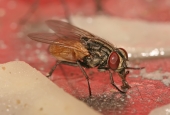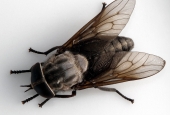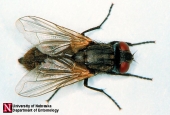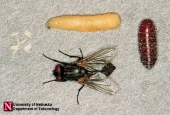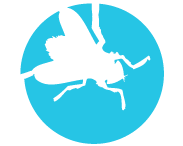Flies undergo a complete metamorphosis, moving from egg to larva to pupa to adult. In domestic flies the females lay small, white eggs (0.25 inch) in moist organic matter. The fly larvae are white, legless maggots that avoid desiccation by remaining in the moist, decaying organic matter. They mature into larvae and crawl out of the moist material to a more protected, drier area to transform into the pupal stage. The pupa is the hard, brown case within which the fly transforms into an adult fly.
Beyond being an annoyance, flies pose a significant risk to public health through their habits of breeding and thriving in sources of filth. Adult flies that feed on garbage, manure, dead animals and compost can transmit bacteria, viruses, and parasites that cause gastrointestinal illness and food poisoning when they land on food or clean surfaces in homes and restaurants. Some flies can also bite and burrow into the skin and can transmit more serious disease agents like anthrax, dysentery, tuberculosis and tularemia in rare cases.
Every fly is different and identifying which fly species is invading your home or business is extremely important in eradication. Once identified, it becomes much easier to locate the breeding source of fly larvae. Removing these sources are often the best form of domestic fly control since using pesticides alone is rarely effective. An integrated pest management (IPM) approach which addresses environmental factors is needed to attain sustained control. IPM includes source reduction or elimination, exclusion, biological control, chemical control and public education. In homes, however, identifying and removing the larval food source (often garbage and rotting food) is usually sufficient.
Our District will inspect your property, identify the fly and make recommendations for the elimination of the larval food source.



